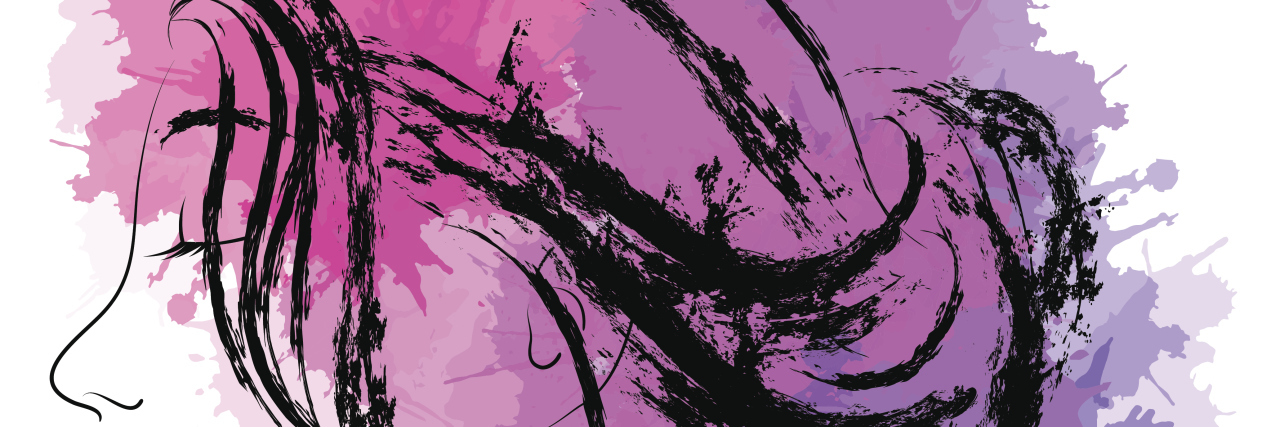Staring into nowhere. Curled in a ball. Hiding under a blanket.
These are a few of the signals I’m freezing up. Internally, though, I’m on fire.
One of the reasons social anxiety and generalized anxiety disorder are often co-morbid with autism is the “Freeze Loop.” AspergerExperts.com argues, “It’s not that they are stuck… It’s that they are terrified. They are literally so terrified, they’re immobilized in fear.”
The Freeze Loop is a new concept for me, although I’ve lived with it for years. So I wanted to illustrate what it looks like, in case it’s new terminology for you, too.
The Stage
Picture everyone in a state of peace. No one is frozen; everyone feels all the feelings.
Then a trigger strikes. Something stressful.
Normally, at this point, we would input feelings, then determine what to do with the processed data. However, as Bradberry and Greaves explain in “Emotional Intelligence 2.0,” “Some emotions create a paralyzing fear that makes your thinking so cloudy that the best course of action is nowhere to be found.”
The Response
Neurotypical people experience something like the Freeze Loop too (that’s why “Emotional Intelligence 2.0” explores it more in-depth), although it manifests differently in people on the spectrum; and autistic people may take a wee longer to return to status quo.
Here are the states of the Freeze Loop, and some of the physical reactions I experience during them:
- Unfrozen; receiving inputs of feelings. All is good here. No one needs to panic.
- Overwhelmed; processing feelings. My palms sweat. Gross. I hate feeling sticky. I talk faster, to get the emotions out as quickly as possible. The impulse to hand-flap is usually suppressed, since if people look, that just adds feelings; but there’s nothing like a good shakeout to get rid of goosebumps. Often I restless knee or rock instead, especially if there’s music to help me establish a rhythm. Society is more accepting of randomly rocking out to the ’90s pop in the grocery store. Self-stimulation of any kind helps, even if it’s a fidget toy. A deer-in-headlights expression always accompanies this phase, with lots of people asking, “You OK,” and a lot of me muttering, “Yeah, just overwhelmed.” A nonjudgmental, interrogation-free glass of water is the best thing to offer an overwhelmed person.
- Panic; meltdown; shutdown. Meltdowns involve throwing things, screaming, beating pillows, and they happen once every year or two. Last time I had one was during my move from my apartment to our duplex; change is hard. I threw shoes at the wall for a half hour. I tell people to remove themselves from a room when an autistic person is having a meltdown, even if they’re like me and have the wherewithal to, well, aim things away from people. Shutdowns are implosive, rather than explosive, and they involve curling in a ball, weeping, hiding under blankets or inside closets, to name a few behaviors. None of these lists are exhaustive. When I was a public school teacher, shutdowns were daily, but in a less stressful atmosphere, they only occur once or twice a month. This can last five minutes to five hours or more. If I can’t processing my feelings fast enough, and I have privacy, I enter this mode. Meltdowns and shutdowns blare inside my head, like a caustic pain, like I’m drinking an ever-filling Slurpee without breathing or blinking.
- Freeze. If it’s not possible to meltdown or shutdown, this is the alternate phase, and it can last anywhere from hours to weeks. If I can’t process my feelings fast enough, and I’m in public, I enter this mode. Horror, disgust, terror, or offensive facial expressions signal to everyone that I’m currently mentally helpless, although the look I offer others may not be interpreted that way. Unfortunately, freeze mode can also swing back into meltdown or shutdown mode; it’s not like there’s a clear-cut decision because it’s emotional.
When an autistic person experiences a Freeze Loop, consider guiding them (if it’s safe) to an alternative way to express their emotions. Writing is my go-to; we have journals and diaries all over this house, half-filled with feelings. Fine arts can also help, though. Printmaking, painting, drawing, glassblowing, and ceramics classes have helped me mitigate my emotions. I’ve heard sports help some people. Bowling used to help me. The Renaissance Faire used to have this stand for throwing old plates at a chipped wall, and that was also effective.
If the Freeze Loop sounds like something you experience, consider setting up a game plan for releasing yourself from your next emotional prison. As cliche as it sounds, find a way to let your feelings out as soon as you can; because when the amygdala rings the alarm bell —and no sight of will-powering calmness is anywhere on the horizon — a tactical strategy can help that interior battle being waged, a whirlwind of a struggle that feels like anything but being stuck. You’ll find a way to release the feelings. It just might take a moment to discover the alternate methods.
Be patient with yourself. Return to the breath.
I treat my emotions like koans, like the upcycling puzzle of life. I never give up on them.
Getty image by Veler

